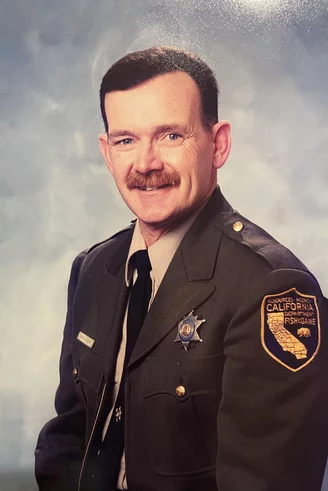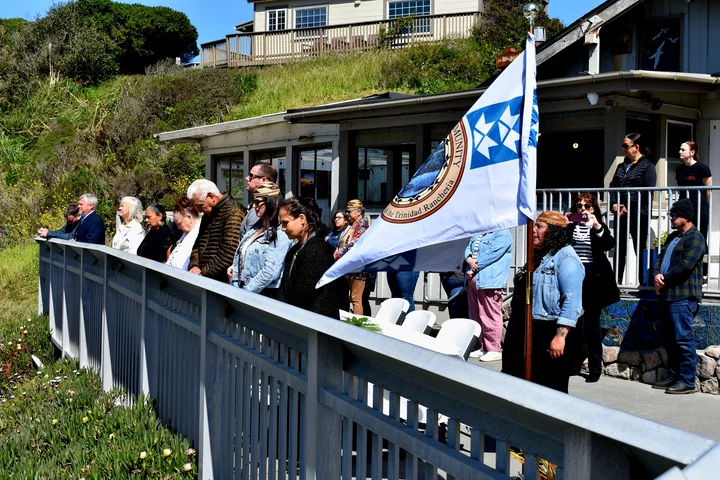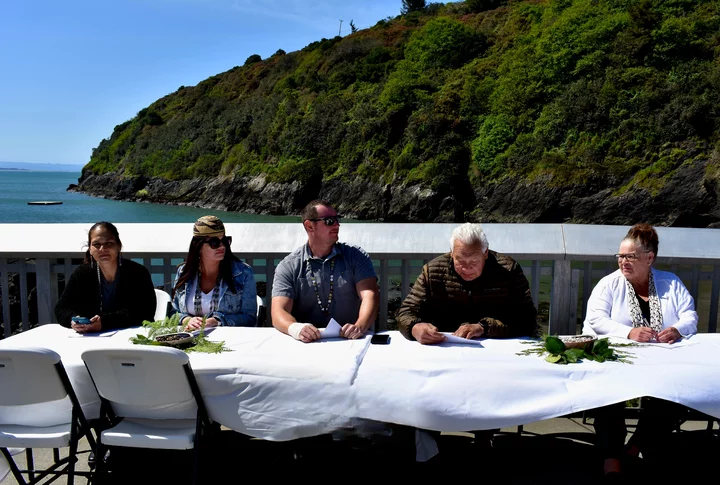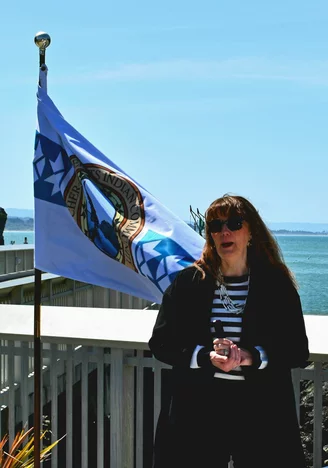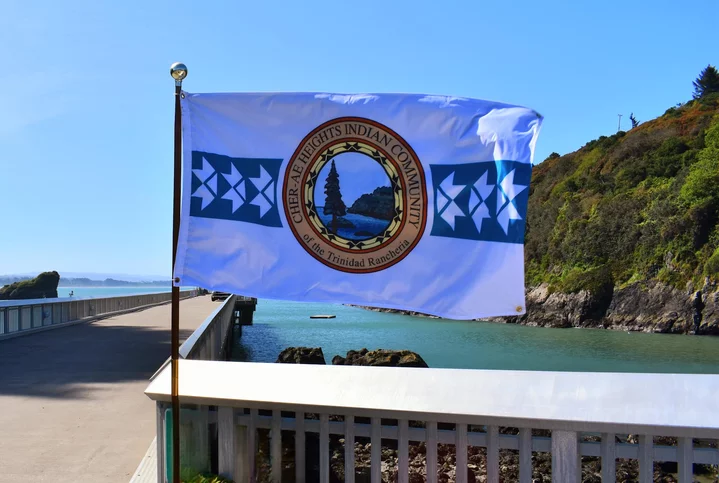OBITUARY: Nicky (Nick) Albert, 1950-2024
LoCO Staff / Saturday, May 4, 2024 @ 6:56 a.m. / Obits
Nicky
(Nick) Albert, son of Nicandro (Nick) and Virginia Albert, was born
on May 18, 1950, in Carmel. He was the second of eight children and
their oldest son. Nick attended grade school in Monterey and
graduated from Monterey High School in 1968 and Monterey Community
College in 1970.
In the summer of 1968 Nick met the love of his life, Patricia Ann Harwood, while working at Yellowstone National Park. Nick and Patricia married on June 22, 1970 and had four daughters.
Nick attended California State University, Sacramento, graduating in 1972. Nick and Patricia lived throughout the Northern California area, including the cities of Sacramento, Monterey, San Francisco and Arcata, before building their dream home in Freshwater in 2010.
Nick was known for his devotion to his family, his loyalty to friends, and dedication to his job as a fish and game warden throughout the Humboldt County area. He was a devoted member of The Church of Jesus Christ of Latter-Day Saints.
Nick lived a life filled with love, adventure, and unwavering dedication to his family and community. A captivating storyteller, drawing from his experiences in the field and his family life, Nick brought joy and laughter to those who knew him. Even in his last days, he enjoyed hearing those stories from friends and family. Nick was never afraid to stand up for what was right and could be counted on to defend others when needed.
On Saturday, April 13, 2024, Nick passed away due to complications related to ALS, leaving behind a profound legacy of love, service, and an unwavering spirit. Though gone, he will forever be remembered by his loving wife, Patricia, his four daughters, and his extensive family and community. A true hero, Nick’s impact will continue to be felt by all who were fortunate enough to know him.
Nick was preceded in death by his parents, Nick and Virginia Albert, and his sister, Robin Cazaux. He is survived and forever remembered by his wife, Patricia, their daughters, Michelle Caisse (David), Jennifer Fritzsche (Karl), Kristen Hodges (Charles), and Nicole Taylor (Robbie), his sisters Valerie Szody (David) and Jill Barnes (Verdis), his brothers Marc (Debbie), Matthew (Jeri), Barry (Mary), Adam (Diane), brother-in-law David Harwood (Barbara), and his uncle Dan (Joann) Albert. Nick is also survived by his 9 grandchildren, Isabelle, Koen, Jonas, Addyson, Fisher, Willow, Olive, Nicky, and June and many nieces, nephews and cousins. A memorial service will be held at 1 p.m. July 12, 2024 at 2351 Freshwater Rd, Eureka.
In lieu of flowers the family requests donations be made to the ALS Association at als.org.
###
The obituary above was submitted on behalf of Nick Albert’s loved ones. The Lost Coast Outpost runs obituaries of Humboldt County residents at no charge. See guidelines here.
BOOKED
Yesterday: 11 felonies, 16 misdemeanors, 0 infractions
JUDGED
Humboldt County Superior Court Calendar: Yesterday
CHP REPORTS
Us101 S / King Salmon Ave Ofr (HM office): Traffic Hazard
ELSEWHERE
RHBB: Catholic Hospital Denies It Violated CA Law, Attorney General Makes Case For Abortion Protection
RHBB: Prescribed Burn Planned for the Huestis Rock Unit, Ft. Seward Area
RHBB: Green Diamond Prescribed Burning Notification for Today
Are You a Public Policy Wonk Into Jurisdiction and Land Use Issues? Humboldt LAFCo Seeks a Public Member
LoCO Staff / Friday, May 3, 2024 @ 4:33 p.m. / Local Government
Press release from the Humboldt Local Agency Formation Commission:
The Humboldt Local Agency Formation Commission (LAFCo) invites interested persons to apply for the position of regular public member on the Commission. The regular public member fully participates in the discussion and deliberation at LAFCo meetings and votes on all items put before the commission. LAFCo meetings are held at least six times per year on the third Wednesday of odd-numbered months at the City of Eureka Council Chambers. The four-year term for the regular public member runs through June 30, 2028.
LAFCo is an independent agency created in each county by the California State Legislature in 1963. LAFCo is responsible for facilitating changes in local governmental structure and boundaries that fosters orderly growth and development, promotes the efficient delivery of services, and encourages the preservation of open space and agricultural lands. LAFCo meets these objectives by regulating the boundaries of cities and special districts and conducting municipal service reviews and other special studies.
Humboldt LAFCo is composed of seven (7) voting members, including two county supervisorial members appointed by the Humboldt County Board of Supervisors, two city council members appointed by the Mayors of the seven incorporated cities, two special district members appointed by the independent special districts, and one public member appointed by full commission. There is also one alternate for each category.
Requirements: Applicants must be residents of Humboldt County, be able to regularly attend LAFCo meetings, have a general understanding of LAFCo functions and authorities, and cannot be officers or employees of a local public agency or a member of a public board, commission, or committee that has the authority to make advisory or final decisions on matters relating to land use or the provision of services. Public members are considered public officials and are required to file a standard annual financial disclosure statement with the California Fair Political Practices Commission.
Please note the regular public member position will remain open until filled. Qualifying candidates may be considered for appointment at the LAFCo meeting on July 17, 2024. Please submit a completed application by June 14, 2024 at 5:00 p.m. for consideration at this meeting. Applications may be submitted by email at info@humboldtlafco.org or by mail to LAFCo 670 9th Street, Suite 202, Arcata, CA 95521. To download an application form and for more information about Humboldt LAFCo, please visit our website at www.humboldtlafco.org, or contact the LAFCo office at 707-445-7508.
In Open Letter to Legislators, Humboldt Jewish Leaders Reject the Notion That the Cal Poly Protests Were Antisemitic
LoCO Staff / Friday, May 3, 2024 @ 2:12 p.m. / Activism
Jewish students speak at pro-Palestinian campus occupation on Monday. File photo: Andrew Goff.
PREVIOUSLY:
###
Open letter from the leadership of Temple Beth El:
Dear Senator Mike McGuire and Assemblymember Jim Wood,
As leaders in the Jewish community in Humboldt County, we express our disappointment in your recent press release in which you referenced “antisemitic hate speech” in connection to the protests at Cal Poly Humboldt. Yes, there have been instances of antisemitism. Yes, there is important work to be done. But we do not find the protests themselves to be antisemitic and we reject it as justification for the police force used against the protesters. This inappropriate justification is all the more problematic because it was done without any consultation with Jewish community leaders.
Our Jewish community is diverse with wide ranging views. We share the distress felt by so many Cal Poly Humboldt students, faculty, and staff over the ongoing violence and tragic loss of life in the Middle East. We have varying opinions about the protests, slogans, and many related matters, nor do we share one definition of antisemitism. The Temple Beth El Antisemitism Task Force holds that the charge must be brought with discretion, carefully taking into account numerous factors in any situation. While some of us have witnessed and are concerned about statements and acts by individuals that we experience as anti-Jewish, we push back against the charge that antisemitism was endemic to the protests at Cal Poly Humboldt or that expressions of it were an appropriate justification for police action.
Senator and Assemblymember, you stated concern for the difficult experience of “Humboldt’s Jewish students and others over the past week.” Yes, the past week has been traumatic, for the entire campus community and community at large. But the problems with antisemitism at Cal Poly Humboldt are not confined to one tumultuous week. Let us explain:
In past decades very few antisemitic incidents on campus came to our attention, and some longtime Jewish faculty report encountering no antisemitism at Humboldt State University (now Cal Poly Humboldt). Jewish faculty and staff have received honors, and rabbis teaching or volunteering on campus have been treated with respect. Similarly, for decades there was very little antisemitic activity in the community at large. But things have changed in recent years. Even before the October 7 massacre, some Jewish students reported feeling marginalized by classmates and instructors.
Since October 7 there has been a surge in antisemitic crimes and incidents off campus and one hate crime on campus right after the massacre before protests began. The charged atmosphere of the protests this winter and spring has left some Jewish students, faculty, and staff feeling intimidated and afraid to openly identify with their religion or celebrate their heritage. One student was viciously harassed and has received little help.
In early February, Jewish community leaders contacted University administration requesting a meeting on urgent problems and solutions. It took three months to get a one-hour meeting. During that time the situation deteriorated, and the University failed to engage with us in any meaningful way. We were surprised to read a recent press release in which the University stated they “have been in touch with Jewish community leaders.” This is inaccurate. Now it appears that our well-intentioned elected officials have been misled by the University.
The protests loudly demonstrated a lack of cultural sensitivity and indifference to alienation of Jewish students with opposing views. The University ignored offers of help from Jewish leaders and failed to provide students, faculty and staff with resources to address antisemitism and support Jewish life on campus. This must change. At a long-awaited meeting on May 2 with the Dean of Students, it was agreed that vigorous, long term effort is needed to educate the Cal Poly Humboldt community about and respond to antisemitism. Crimes and discrimination must be taken seriously, and spurious charges of antisemitism must be scrupulously avoided.
We appreciate your service to the community and want to make sure you understand the risks of potential harm and escalation that come from a politicized use of the term antisemitism. We would like to work with you directly to address these complex problems and the nuances required for future communications.
Rabbi Naomi Steinberg, Lecturer Emerita Cal Poly Humboldt
Rabbi Bob Rottenberg
Courtney Ladika, M.D., Temple Beth El President
Caroline Connor, M.D., M.P.H., Temple Beth El Vice President
Emeritus Professor Ann Alter, Temple Beth El Board Secretary
David Boyd, Temple Beth El Antisemitism Task Force
Due to Ongoing Campus Closure, Cal Poly Humboldt Will Instead Hold Graduation Ceremonies at Multiple Sites Across the County
LoCO Staff / Friday, May 3, 2024 @ 1:13 p.m. / Education
Cal Poly Humboldt release:
Cal Poly Humboldt has adapted its Commencement plans so that this important celebration for graduates and their guests can be held even though the campus remains closed.
The University will hold modified ceremonies at three off-campus locations on Saturday, May 11, 2024. They will take place concurrently in the Sapphire Palace at the Blue Lake Casino, the Eureka Theater, and the Eureka High School Auditorium. Each of the venues has the capacity to accommodate all of the registered graduates’ anticipated guests.
The University’s Regional Commencement ceremony, scheduled for Tuesday, May 14, 2024, at The Saban Theatre in Beverly Hills, will take place as scheduled.
For the Commencement ceremonies on May 11, each of the three Colleges will hold multiple ceremonies, organized by major, during the course of the day. The ceremonies will be led by the Dean and Associate Dean of each of the Colleges, with support from an additional academic leader.
Graduates will be organized by major:
Blue Lake Casino Sapphire Palace - College of Arts, Humanities & Social Sciences (777 Casino Way, Blue Lake, CA)
8:30 a.m. - Art, Dance Studies, Film, Fine Art, Music, Theatre Arts
10:30 a.m. - Anthropology, Environmental Studies, Geography, Geospatial Science & Technology 12:30 p.m. - Criminology & Justice Studies, Critical Race, Gender & Sexuality Studies, Native American Studies, Sociology, MA Sociology 2:30 p.m. - English, French & Francophone Studies, International Studies, Philosophy, Political Sciences, Spanish, MA English 4:30 p.m. - Communication, History, JournalismEureka Theater - College of Professional Studies (612 F St, Eureka, CA)
8:30 a.m. - Elementary Education, Leadership Studies, MA Education, Administrative Services Credential; Education Specialist Credential; Multiple Subject Credential; Single Subject Credential 10:30 a.m. - Business Administration, Economics, MA Business Administration 12:30 p.m. - Child Development, Child Development & Family Relationships, Psychology (Students with last names A-L) 2:30 p.m. - Psychology (Students with last names M-Z), MS Psychology 4:30 p.m. - Individualized Degree Plan, Kinesiology, Nursing, Recreation Administration, MS Kinesiology 6:30 p.m. - Social Work, MA Social Work
Eureka High School Auditorium - College of Natural Resources & Sciences (1915 J St. Eureka, CA)
8:30 a.m. - Biology, MS Biology 10:30 a.m. - Computer Science, Data Science, Environmental Resources Engineering, Geology, Mathematics, Physical Science, Physics, MS Engineering & Community Practice 12:30 p.m. - Environmental Science & Management, MA Environmental Systems 2:30 p.m. - Forestry, Rangeland Resource Science, MS Natural Resources 4:30 p.m. - Fisheries Biology, Marine Biology, Oceanography, Zoology 6:30 p.m. - Botany, Chemistry, Wildlife
The Cultural Graduation Celebrations will be held Thursday and Friday at the Adorni Center in Eureka.
Asian, Desi, Pacific Islander, Middle Eastern, and North African (ADPI+MENA) Graduation Celebration Friday, May 10; 4 – 6 p.m.
Black Graduation Celebration Friday, May 10; 1 – 3 p.m.
Latine/x Graduation Celebration Friday, May 10; 7 – 9 p.m.
All Native Graduation Celebration Thursday, May 9; 6 – 8 p.m.
Queer Graduation Celebration Friday, May 10; 10 a.m. – Noon
Cal Poly Humboldt is unable to hold this Spring’s Commencement on campus as planned because of the recent emergency. The campus remains closed due to clean-up work, concerns about maintaining the security of buildings, and the ongoing criminal and campus conduct investigations.
Facilities staff on campus typically spend a month or more preparing for Commencement, and that has not been possible. Those same staff have been responding to the campus emergency, and now they are focused on the extensive clean-up following the restoration of order to campus. There is no way, at this point, to get the campus ready to host graduates and thousands of guests.
For questions about Commencement registration contact grad@humboldt.edu. For more information, please visit: commencement.humboldt.edu.
Tribal Sovereignty Win: Feds Place 9.3 Acres Into Trust for Exclusive Benefit of the Trinidad Rancheria
LoCO Staff / Friday, May 3, 2024 @ 1:12 p.m. / Tribes , Trinidad
Trust Signing Opening Prayer. | All photos via Trinidad Rancheria.
###
Press release from the Trinidad Rancheria:
The Cher-Ae Heights Indian Community of the Trinidad Rancheria (Trinidad Rancheria) is proud to announce that the US Department of the Interior, Bureau of Indian Affairs has placed the Trinidad Harbor Properties into Trust for the Trinidad Rancheria. The completion of this landmark land-into-trust transfer, solidifies the sovereignty and self-determination of the Trinidad Rancheria.
The transfer, commonly referred to as a fee-to-trust acquisition, signifies a significant step forward in the Tribe’s efforts to assert jurisdiction over our ancestral lands and resources. Under this agreement, the Trinidad Rancheria facilitated the transfer of land title to the federal government, which will now hold the land in trust for the exclusive benefit of the Trinidad Rancheria.
“We are here today to celebrate this land-into-trust transfer as it is a monumental achievement for the Tribe,” said Garth Sundberg, Trinidad Rancheria Chairman. “With this action, we reclaim our inherent rights to stewardship over our lands and resources.”
Left to Right: Trinidad Rancheria Tribal Councilmembers: Secretary/Treasurer Trina Mathewson, Councilwoman Aprilskye Hemsted, Vice Chairman Robert Hemsted, Chairman Garth Sundberg, and BIA Regional Director Amy Dutschke.
###
Trinidad Rancheria Chairman Garth Sundberg and Bureau of Indian Affairs Regional Director Amy Dutschke executed the Grant Deed and Acceptance of Conveyance during a formal signing event at the Trinidad Harbor Seascape Restaurant on May 1, 2024. The signing event attended by the Trinidad Rancheria Tribal Council and Staff, BIA Regional Director and Staff, Trinidad City Mayor Cheryl Kelley, Board of Supervisor Rex Bohn, and District Representative John Driscoll on behalf of Congressman Jared Huffman.
“Today we accept the responsibility of the governance of these Tribal lands and acknowledge the sacrifices of our ancestors since time immemorial,” stated Robert Hemsted, Trinidad Rancheria Vice Chairman. “We shall continue to move forward in the spirit of our Original Assignees.”
The acquisition of land in trust is not merely symbolic; it carries tangible benefits for the Trinidad Rancheria and its tribal members. By placing land into trust, the Tribe gains greater control over land management decisions, enhances access to crucial resources, and maximizes eligibility for federal services and programs aimed at improving the well-being of Tribal communities.
Aprilskye Hemsted, Trinidad Rancheria Councilwoman, expressed, “Being here on this historic day is truly an honor. We’ve waited a long time for this moment, and it’s immensely gratifying to witness our hard work yielding positive results as our goals and projects reach completion.”
The successful completion of this land-into-trust transfer reflects the culmination of comprehensive mitigation and cleanup of hazardous waste, renovation of harbor infrastructure, and numerous legal challenges. It stands as a testament to the resilience and determination of the Tribal community to safeguard our cultural heritage and secure a prosperous future for generations to come.
Jacque Hostler-Carmesin, Trinidad Rancheria CEO, stated, “The Trinidad Rancheria Tribal Council, Tribal Members, and Tribal Staff have worked tirelessly to ensure these 9.3 acres were secured in Trust for the Trinidad Rancheria. This endeavor epitomizes Indian Self-Determination and Tribal Sovereignty, prioritizing the preservation of cultural and environmental treasures. Moving forward, we remain steadfast in our commitment to fostering commercial and recreational fishing activities, while also extending a warm welcome to visitors and kayakers eager to explore our stunning harbor.”
The Trinidad Rancheria is grateful to all those who have contributed to this historic endeavor, including tribal members, community members, government officials, and partnering organizations. Your dedication, perseverance, and unwavering support have been instrumental in realizing this milestone achievement.
“This is a significant moment for me”, Trina Mathewson, Trinidad Rancheria Secretary / Treasurer, reflected. “My grandmother, Carol Ervin-Tripp, served as Chairwoman in the 90s, dedicating over 20 years to our community. This achievement was her vision for our people, and I’m thrilled to see her dedication bearing fruit. She would be proud.”
The process to place land into trust requires coordination among multiple stakeholders, compliance with legal and regulatory requirements, and careful review of land titles and environmental considerations. The Bureau of Indian Affairs plays a critical role in facilitating the trust acquisition process, ensuring compliance with legal and regulatory requirements, and safeguarding the interests of the Trinidad Rancheria.
“It is my pleasure to be here and I am honored to take this land into Trust on behalf of the Secretary of the Interior”, said Amy Dutschke as she signed the Acceptance of Conveyance. “This land will now be held by the United States on behalf of and for the benefit of the Trinidad Rancheria. Forever!”
Last Night’s Structure Fire on Ole Hanson Road Deemed Suspicious, Says Humboldt Bay Fire
LoCO Staff / Friday, May 3, 2024 @ 10:18 a.m. / Fire
Press release from Humboldt Bay Fire:
On 5/02/2024 at 20:26 hrs. Humboldt Bay Fire responded to a reported Structure Fire at 53 Ole Hansen Rd Eureka. Humboldt Bay Fire responded with 1 Chief Officer, 3 Engines, 1 Water Tender and 1 Truck for a total of 14 fire service personnel. Additionally, 1 volunteer Fire Support personnel responded and provided traffic control.
The first Engine arrived on scene and reported a working fire in a residential structure and began to attack the fire. The second arriving unit was assigned to search the interior of the residence for any potential victims and the third arriving unit was assigned to Safety. The fourth arriving unit was assigned to Ventilation. The fire was controlled in 10 minutes and no occupants were in the residence.
Humboldt Bay Fire remained on scene for an additional 2 hours to completely extinguish the fire and conduct a cause and origin investigation of the fire. The cause of the fire is undetermined under suspicious circumstances. PG&E arrived on scene and confirmed the electrical and gas service to the residence was disconnected. There were no civilian or Firefighter injuries and the value of the property is estimated at $250,000 and damage from the fire is estimated at $25,000.
Humboldt Bay Fire would like to thank HCSO, City Ambulance, PG&E, Samoa- Peninsula Fire and Arcata Fire for their assistance on scene and providing coverage to other emergency calls during this incident.
Humboldt Bay Fire would like to remind everyone to immediately call 911 and get outside in the event of a fire in your home and to please have a designated meeting place Smoke Alarms Save Lives. outside your home in case of a fire so all occupants of the home can be accounted for by arriving fire service personnel.
###
‘We Needed Wonder Woman’: Newsom Cuts to Foster Care, Child Services Worry Families
Wendy Fry / Friday, May 3, 2024 @ 8:09 a.m. / Sacramento
State Sen. Caroline Menjivar, a Democrat from Van Nuys, criticized proposed cuts to foster care, family programs. 2023 photo by Rahul Lal for CalMatters
Last week Ed Center, a foster parent from San Francisco County, told a Senate budget subcommittee a painful story about reaching his breaking point during his son’s COVID-era mental health crisis. His son’s breakdowns included violent tantrums and blacking out his own face from family portraits with a marker.
“When we were in crisis, we needed Wonder Woman with a social work degree,” Center explained. That’s what he said his family found in the Family Urgent Response System, a free, trauma-informed support system for foster youth and their caregivers. The $31 million state program sends counselors out to families in crisis at all hours.
Now, as the state faces a budget shortfall that the Legislative Analyst’s Office predicts could be as much as $73 billion, programs the state funded during times of surplus are on the chopping block.
Gov. Gavin Newsom’s January budget proposal would eliminate the family emergency response program and delay, cut, or eliminate other programs aimed at providing a safety net for families. Newsom will present a revised budget by mid-May, based on updated revenue estimates.
Advocates say the cuts will undermine the state’s goals to help vulnerable Californians and those trying to escape poverty.
“All of our programs at CDSS impact people experiencing need or vulnerability, so any proposed reductions are very difficult,” Jennifer Troia, the Department of Social Services chief deputy director, told the committee. “The choices that we are facing as the administration and Legislature in light of the state’s fiscal situation are indeed very difficult.”
The family urgent response program received 4,987 calls for help from January through December 2023, and its staff responded in person to a family in crisis 1,090 times. The Los Angeles County Department of Children and Family Services, which received the most calls, said 87% of in-person responses resulted in a stabilized placement of the foster child.
Foster care sacrifices
Some of those calls came from Center and his family, which is now stable, he said. But one desperate night, when his family was struggling, the foster father said he drove three hours away from home before calling for help.
“I asked the counselor a simple question: ‘Why should I go back?’” he recalled.
The social worker reminded Center how much he mattered to his son, even if his then 10-year-old couldn’t show it at the time.
“I bought some crappy gas station coffee and I turned around for home,” Center said.
His story brought tears to the eyes of state Sen. Caroline Menjivar, a Democrat from Van Nuys who is chairperson of the subcommittee. “It’s been a tough week,” she said, her voice cracking as she reached for tissues.
“Your kid could have been a statistic. He could have been homeless, died by suicide, or you would have had a broken family, and it wouldn’t have been your fault. It would have been because the system failed you,” Menjivar told Center.
Many of the budget priorities set by Newsom and other lawmakers seem out of touch, said Menjivar, who served seven years in the Marines and has worked as an emergency medical technician.
“I come from a working, low-income community; some crossed the border to come here for a better life for their children,” she told CalMatters on Wednesday.
“My mom cleans houses still to this day. I had to start working at age 15 because I needed to help my mom.”
Budget priorities
Menjivar said she gets frustrated talking about bills on such issues as artificial intelligence when her constituents struggle to put food on the table or to buy feminine hygiene products, reflecting California’s wealth inequality. Top-earning families made 11 times what the bottom 10% earned in 2022 — $305,000 vs $29,000, according to the Public Policy Institute of California.
In his January budget proposal, Newsom called for at least $66 million in general fund cuts to services for children, families, and foster youth involved with the state’s child welfare system.
His plan includes eliminating a $13.7 million program that helps former foster kids find housing, an $18.8 million housing supplement for foster children ages 18 to 21, and an $8.3 million program that provides public health nursing services for children, youth, and families in LA County.
Menjivar asked state Department of Finance staff how these efforts were selected for program-ending cuts and suggested the decision-makers must have been playing ‘pin the tail on the donkey’ to choose what to cut.
“The solutions reflect difficult decisions in order to achieve a balanced budget,” said Marlon Davis, a budget analyst with the finance department. “Despite these solutions, the administration remains committed to the well-being of children in the child welfare system.”
Menjivar was not impressed: “They’re just the same robotic, copy-and-paste responses. The answers are subpar,” she told CalMatters.
Where else to look
State officials said the family urgent response program is not being fully used in every county, but the governor is willing to work with lawmakers to find other places to cut.
Menjivar recommended looking at state-funded media campaigns as an example.
In 2022, Newsom proposed spending $65 million a year on “strategic communications for community partnerships” to conduct engagement campaigns about COVID-19 vaccination, water conservation, and extreme heat.
His January budget proposal would claw back $5 million from it in 2023, and $8 million in 2024 and 2025, leaving $57 million.
Menjivar also noted the governor has proposed delaying, rather than cutting, $74 million from the Health and Human Services Innovation Accelerator, an initiative to “create the environment for researchers and developers to create solutions” to such health challenges as diabetes, maternal and infant mortality, and infectious diseases.
“Things do have to get cut somewhere,” said Menjivar. “But never, ever, ever from kids and our most vulnerable.”
###
The CalMatters Ideas Festival takes place June 5-6! Find out more and get your tickets at this link.
CalMatters.org is a nonprofit, nonpartisan media venture explaining California policies and politics.

